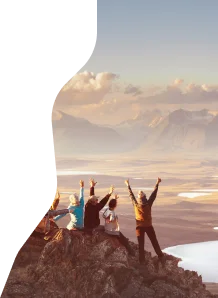Colorado’s Hanging Lake looks like a lost world. This calm, turquoise lake stands over 7,000ft (2,134m) above sea level amid the mountains and valleys of Glenwood Canyon. Fallen tree trunks and branches float in its blue crystalline water, and cascades tumble down moss and rock from the steep cliffs around.
Colorado’s incredible natural wonder is one of only two hanging lakes in the world. It was formed when the travertine (a form of limestone) rocks here collapsed, dropping 1.5 acres (0.6 hectares) of mountain down a fault line and forming the dip in which the lake now sits.
The lake overlooks the valley of Glenwood Canyon | © Culture Trip
Water flowing down Bridal Veil Falls has left deposits, helping shape the lake. The same carbon deposits give the pool its bright color. It’s a fragile environment, but you can still hike here year-round to savor a unique natural phenomenon.
A History of Hanging Lake
Hanging Lake is in western Colorado, around a three-hour drive west of Denver. The first account of the lake tells of a man searching for gold who found a dead horse at the entrance of a ravine. He followed a stream up the steep gulch and found its source – a strange highland lake with turquoise waters and cliffs at its back.
It became a private homestead, but is now run by the Forest Service. It’s unsurprisingly popular with hikers (there’s no direct road access), and to keep the area pristine, permits are required for access.
Visiting Hanging Lake
To hike to Hanging Lake in summer (May to September) you’ll need a permit (currently $12). This allows you to park at the Hanging Lake Welcome Center (110 Wulfsohn Road, Glenwood Springs) and get a shuttle to the trailhead. In winter, a $10 permit lets you park directly at the trailhead.
From here, it’s 1.2 miles (1.9 kilometers) to the lake. The trail is steep – climbing around 1,000ft (305m) – and rocky, and hiking boots, suncream and water are recommended in summer. In winter, mini-crampons and hiking poles are advised – the trail gets very icy, and heading off-trail is prohibited to protect the backcountry.
Become a Culture Tripper!
Sign up to our newsletter to
save up to $1,656 on our unique trips.
While steep, the route is an enjoyable one, with good places to pause and take stock of the impressive canyon – there are also handrails on the tougher sections. The lake itself has a boardwalk with information panels and is a stunning place. Tangled branches, mossy limestone cliffs and tumbling falls frame the turquoise pool, and communities of hanging plants dangle down around its edge.
You can’t swim or fish here, but a trail connects the lake with Spouting Rock, where icy water rushes through a hole in the rock, spraying walkers as they pass.
Iyake Lake
There’s only one other suspended lake in the world – Iyake Lake in southwest Nigeria. Set near the town of Ado Awaye, around a four-hour drive north of Lagos, this mountaintop lake has great views and a number of legends associated with it – including that it was once a woman, and that it can answer spiritual questions.
There are other sights to see on the five-hour hike to the lake and back. The Elephant Tree is – as you might have guessed – a tree that looks like an elephant, and the Esè Àwon Àgbà are large footprint-shaped holes associated with long-gone giants. The route climbs through woodland and bare rock, with steps cut into the stone and soil in places. Iyake Lake’s water level never seems to change, despite the variations in rainfall, and it’s forbidden to swim here.
Lakes at the top of the world
Hanging Lake and Iyake Lake may be the world’s only suspended lakes, but there are alpine lakes in regions around the world (the distinction between the two kinds of lakes isn’t always clear). Alpine lakes, like Hanging Lake, are often clear, due to the cooler mountain water, which inhibits algae growth. They tend to form in depressions caused by high-altitude glacial erosion, or craters left by volcanoes.
Famous examples include Crater Lake in Oregon, which at 1,949ft (594m) is the the USA’s deepest, Lake Kawaguchi near Mount Fuji in Japan, which is a popular tourist attraction, and Lake Titicaca, the huge, 12,500ft-high (3,810m) Andean lake that’s home to Inca ruins.
Culture Trips launched in 2011 with a simple yet passionate mission: to inspire people to go beyond their boundaries and experience what makes a place, its people and its culture special and meaningful. We are proud that, for more than a decade, millions like you have trusted our award-winning recommendations by people who deeply understand what makes places and communities so special.
Our immersive trips, led by Local Insiders, are once-in-a-lifetime experiences and an invitation to travel the world with like-minded explorers. Our Travel Experts are on hand to help you make perfect memories. All our Trips are suitable for both solo travelers, couples and friends who want to explore the world together.
All our travel guides are curated by the Culture Trip team working in tandem with local experts. From unique experiences to essential tips on how to make the most of your future travels, we’ve got you covered.
Source link : https://theculturetrip.com/north-america/usa/colorado/articles/colorados-remarkable-hanging-lake
Author :
Publish date : 2021-07-22 03:00:00
Copyright for syndicated content belongs to the linked Source.
